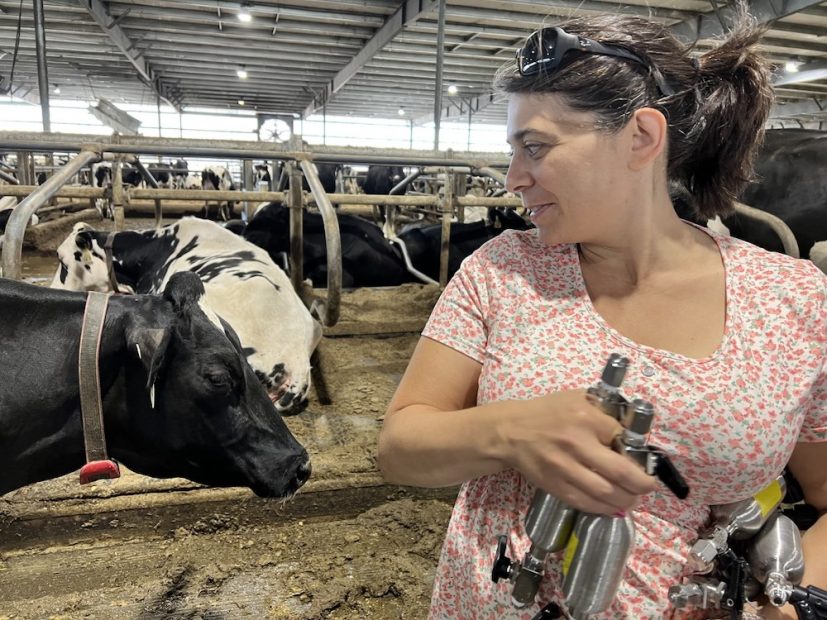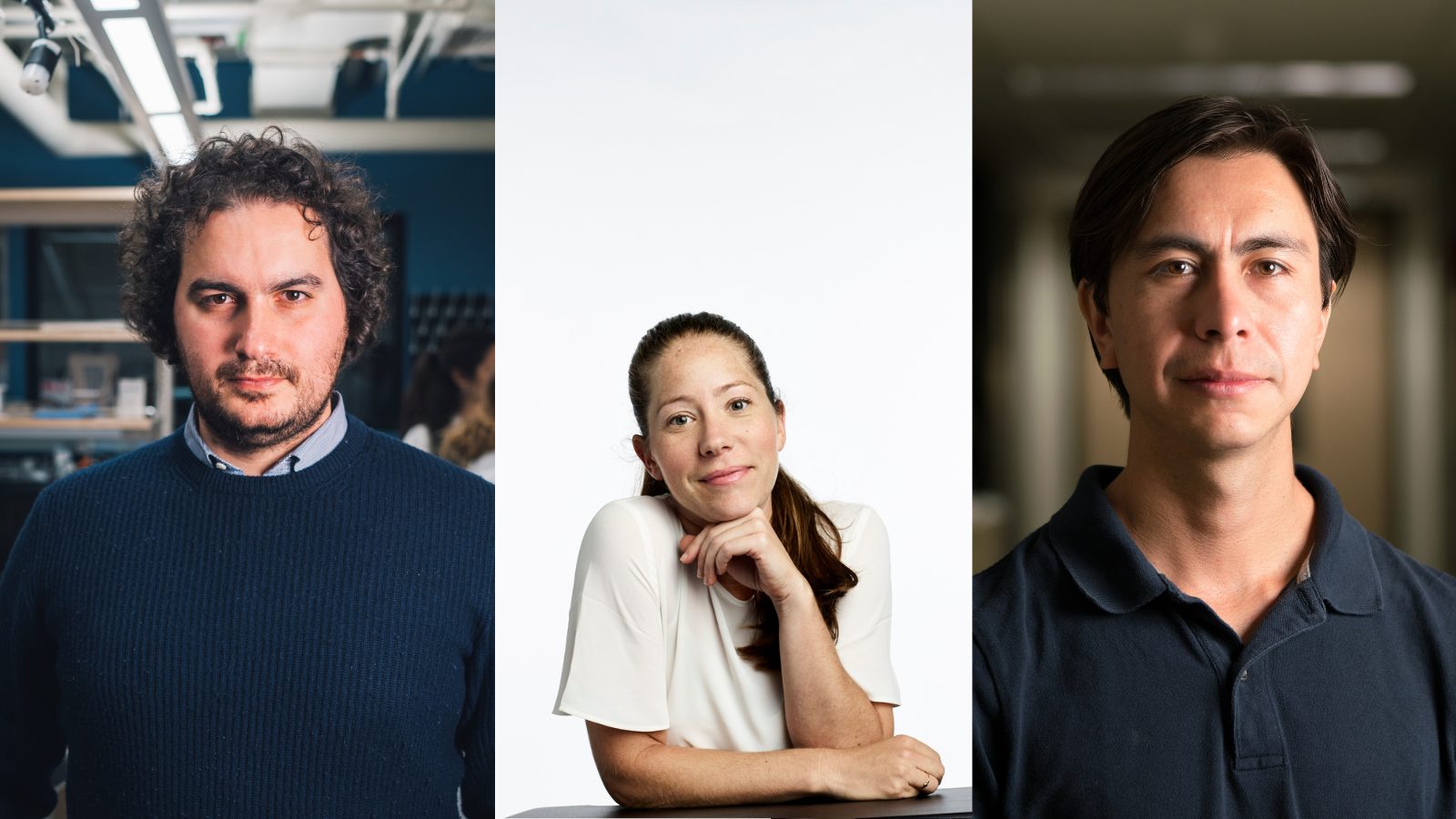Straight from the cow’s mouth

Desirée Plata aims to capture methane before it warms the climate.
At one of the nation’s largest dairy farms, environmental engineer Desirée Plata and her students wade through the muck of a thousand cattle. Inside the football field–sized barn, some animals sniff curiously at the devices Plata and her team are using to measure levels of methane in the air.
As part of their digestive process, cows and other livestock belch methane, releasing large quantities of the colorless, odorless gas to the atmosphere. Agriculture is the largest source of methane emissions in the United States, with oil and gas operations a close second.
According to the U.S. Environmental Protection Agency (EPA), methane is the second most impactful human-generated greenhouse gas after carbon dioxide (CO2). Over the past two centuries, concentrations of methane—120 times stronger than CO2 at trapping heat in the atmosphere—have more than doubled.
Plata, an associate professor of civil and environmental engineering at MIT, has developed tools aimed at reducing methane emissions. The good news, she says, is that because methane is short-lived compared to CO2, cutting methane could have a fast, beneficial effect on atmospheric warming.
Plata is director of the MIT Methane Network—a group of more than two dozen researchers around the Institute and elsewhere dedicated to reducing methane emissions through innovative technologies, business strategies, and policies. The goal is to cut emissions by 45% by 2030, which would save up to 0.5 degree Celsius of warming by 2100. “By removing methane,” Plata says, “we could potentially avoid critical climate tipping points.”
Sustainable from the start
When she was seven or eight years old, Plata was driving with her mom through her rural hometown a short distance from the Atlantic coast. It struck her that many of the people they knew were sick—some with cancer, some with what turned out to be neurological diseases. “I said, ‘It’s gotta be something everybody shares, Mom.’”
Some residents didn’t want to believe they were being sickened by the family-owned McKin Company, a seven-acre liquid waste disposal site that stored and buried toxic fuels, solvents, and chemicals such as trichloroethylene. In 1977, the EPA confirmed that the chemicals had leached into private wells, contaminating the groundwater.
“The thing that has really drawn me to environmental science and engineering is that this is a small town, and the people who owned that facility were family friends,” Plata says. “It made me realize that we, as scientists, need to do a better job helping industries identify more environmentally sustainable routes to profitability.”
At Union College, Plata studied chemistry. She earned her doctoral degree in chemical oceanography and environmental chemistry from the MIT/Woods Hole Oceanographic Institution’s Joint Program in Oceanography.
“In grad school, I asked my professors if I could poke around the other engineering labs at MIT and ask people what they were making, how they were making it, and how [an environmental engineer] might help them make their design and innovation process sustainable from the start,” she says. “That’s the underlying theme of all that I do—help people build better technologies” in the hope of avoiding another McKin Company.
In 2021, she received MIT’s Harold E. Edgerton Faculty Achievement Award for “excellence in service, mentorship, and research that impacts critical societal challenges in environmental sustainability and social justice.” She mentors undergraduates pursuing energy research through the MIT Energy Initiative (MITEI) Undergraduate Research Opportunities Program (UROP). She also serves on the faculty steering committee for MITEI’s Future Energy Systems Center, which looks at how technology and policy, demographic trends, and economics are reshaping energy supply and demand.
Catalyzing a solution
Plata’s primary teaching focus is aquatic sciences and water engineering. Her knowledge of oceanography got her thinking about how to neutralize methane the way certain ocean-dwelling microbes do—by processing it before it escapes into the oceans and the atmosphere.
When Plata and colleagues measured methane leaks from natural gas infrastructure, the overall levels coming from distribution pipelines were small, yet the problem was pervasive. “We were thinking, ‘What engineered way could we take this low-level methane and turn it into something else?’”
Plata’s lab found that passing methane through a heated zeolite—a clay-like material with a consistency between baby powder and cat litter—can help convert methane into CO2 without a match or any other combustion process.
Converting methane to CO2 may sound like a bad idea, but because methane is the more onerous contributor to global warming, it ends up being a net benefit. “And because methane is much more dilute than CO2, the relative CO2 contribution is minuscule,” she says.
Initially, Plata’s team envisioned incorporating zeolite into household air filters. But they decided to focus on the biggest methane offenders: dairy barns and coal mines.
The first time Plata toured a large indoor livestock facility, she was struck by the enormity of the air-moving systems that keep the cows’ air fresh and germ-free. The sheer volume is “astronomical—it’s like 10 tractor trailers moving past you in five seconds.
“That’s our chief technical challenge—getting huge volumes of air” through the zeolite, she says.
At the moment, potential solutions are too energy-intensive for Plata’s taste. “When you’re proposing a climate technology, you don’t want to eat up more fossil fuels than you’re going to offset,” she says. But it’s early days, and plenty of strategies are left to explore.
The payoff could be significant. Deploying the technology in ventilation shafts at coal mines would have such a big effect, it could start to measurably reduce atmospheric levels of methane almost immediately. “And if you could deploy the filters at dairy barns, you’d solve the methane warming problem,” she says. “It’s equivalent to taking all the combustion engine vehicles in the entire world off the road—times three.”

As an engineer working on real-world solutions, Plata strives to design innovations that companies want to adopt because they’re better for the environment, they perform better—and also because they cost less than existing technology.
However, even with her emphasis on cost co-optimization, Plata has noticed a shift in how corporations and individuals view potential costs associated with sustainability. “There’s been a huge swing in the desire to spend a little extra money to prevent environmental damage. Today, people will come to us and say, ‘We want to fix this problem because of the environment. And even if it costs us a little bit more, we’re willing to do it.’”
When Plata thinks back on what happened in Maine, she doesn’t believe the McKin Company was evil, or even hiding the truth. A lot of the time, she says, polluters don’t know about the effect they’re having on the environment. Or if they know, they don’t know how to fix it.
“That’s where our expertise can come in,” Plata says. “We can say, ‘Let’s think about this problem a little differently. How do we get you the function you want without the damage?’
“One of the things my background and upbringing have taught me is: Industry and the people within industry, these are your neighbors. And they probably want the right outcome if you can innovate with them or help guide them to that.”
Reposted from MIT Energy Initiative Spring 2023 Energy Futures newsletter
Share on Bluesky


